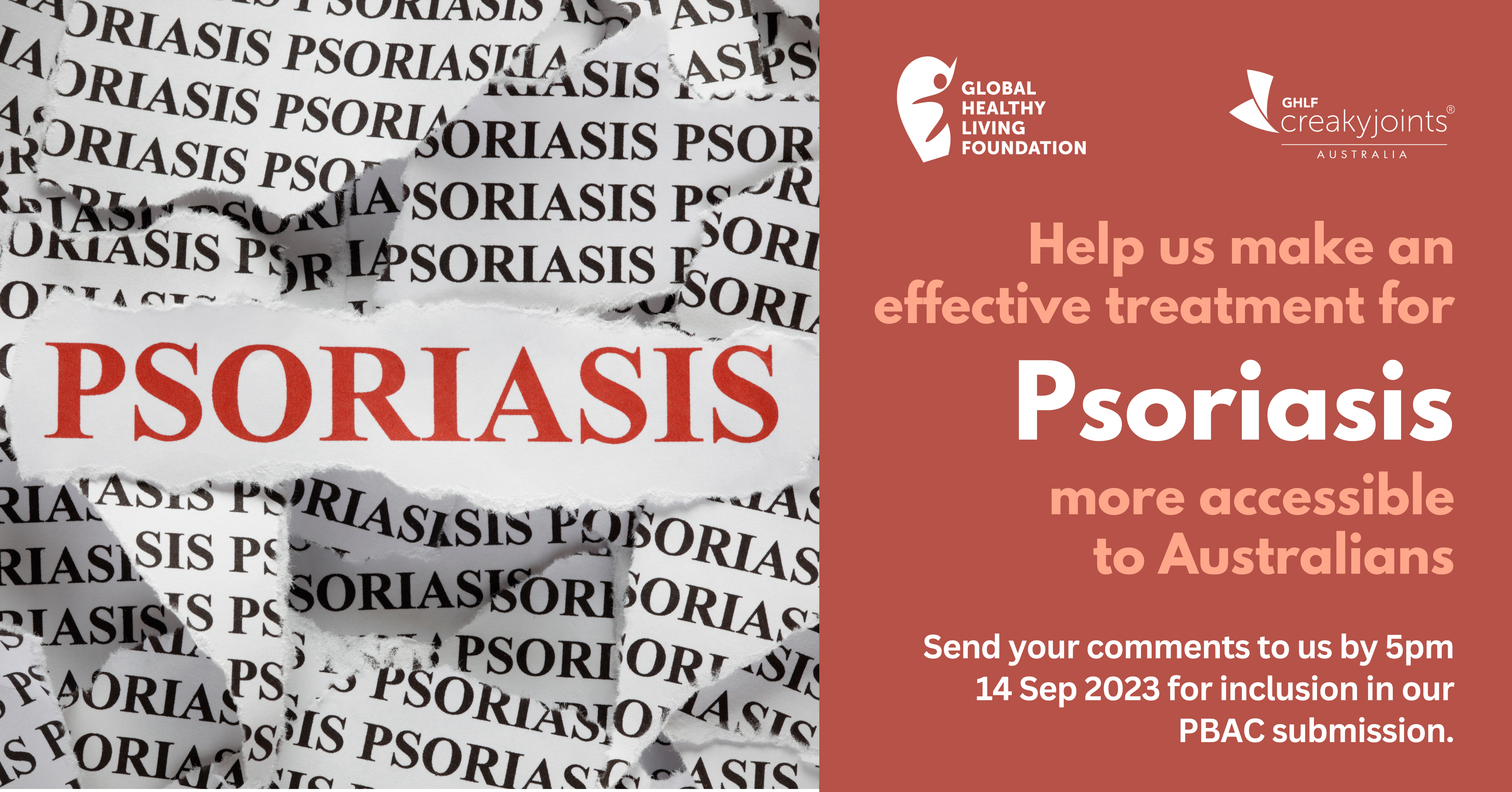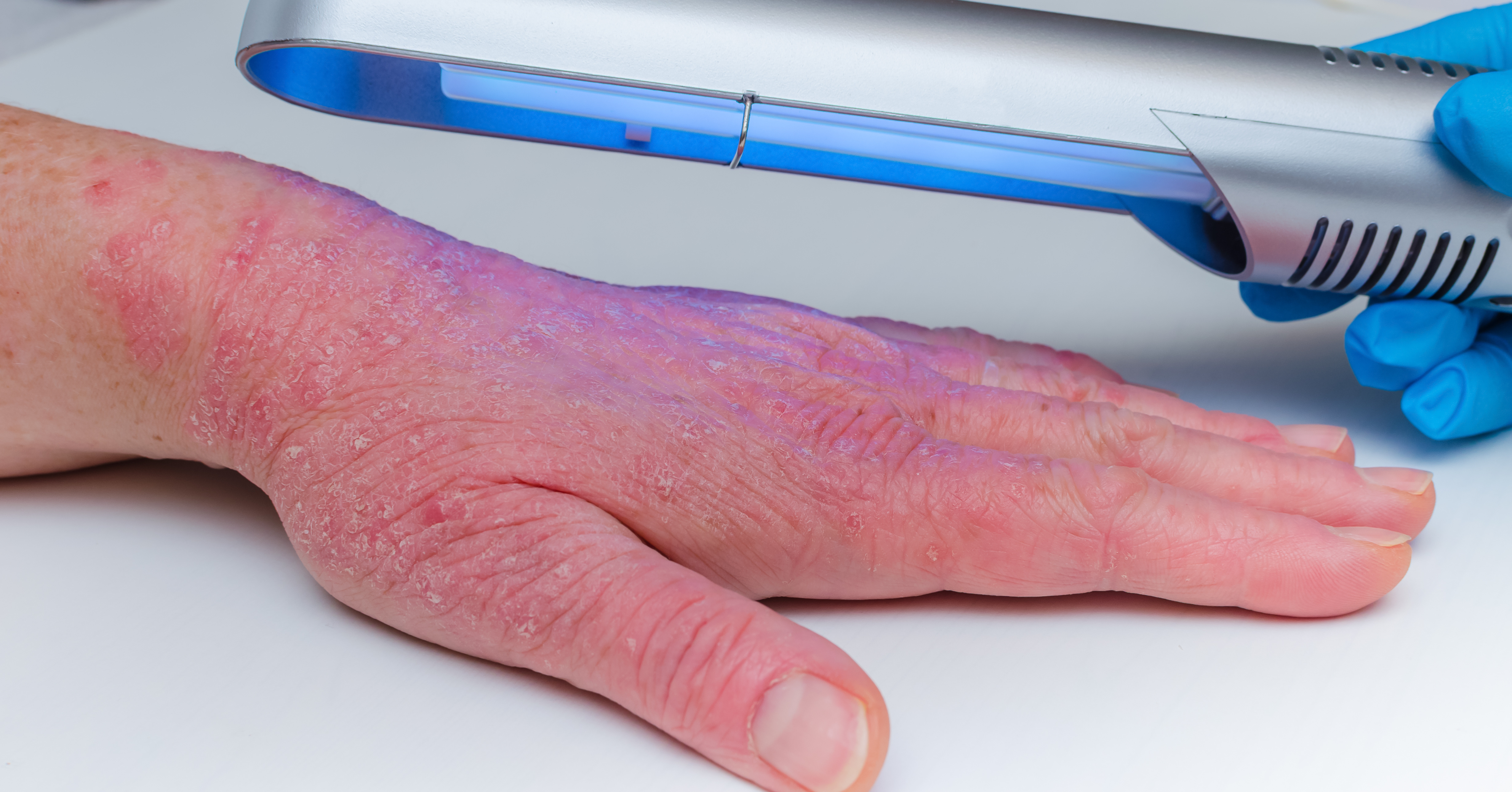Two new breakthrough treatments brings fresh possibilities for those living with chronic plaque psoriasis.... Read more >

Top tips for managing the fatigue that comes with psoriasis
Top tips for managing the fatigue that comes with psoriasis
How can a skin condition make you feel so drained of energy? People associate psoriasis with its visible symptoms, such as patches of red, flaky skin. Yet fatigue can be one of its most debilitating symptoms. These practical strategies will help you better understand your fatigue and how to manage it.
Published 14 June 2023

Psoriasis is a painful inflammatory skin disorder that accelerates the life cycle of skin cells so they regenerate over several days rather than several weeks. It is believed to be caused by a combination of genetics and environment and triggers such as stress or illness.
It occurs when the immune system goes into overdrive and attacks healthy skin cells as though they were damaged or infected. This leads to visible symptoms such as red, itchy, flaky skin patches and thick, pitted fingernails. However, psoriasis also has invisible symptoms including debilitating pain, depression, poor self-esteem and fatigue.
While fatigue is common in the general population and has many causes, psoriatic fatigue can be due to:
- Active inflammation, especially when physical psoriasis symptoms flare up.
- Chronic pain.
- Itchy or irritated skin.
- Certain medications, such as methotrexate or strong pain killers.
- Co-occurring medical conditions, such as psoriatic arthritis, thyroid conditions or diabetes.
- Lifestyle factors including stress or poor diet.
Fatigue is often overlooked as a symptom of skin diseases despite patients frequently reporting it. A 2020 study published in the journal Acta Dermato-Venereologica analysed the five most common skin diseases (psoriasis, atopic dermatitis, acne, rosacea and contact dermatitis). The authors found patients with skin diseases report fatigue more frequently and more intensely than controls. Therefore, clinicians should take this symptom into account.
What is fatigue and what does it feel like to have it?
Many people think fatigue is just another word for tired, but it is much more than that. It is a feeling of being extremely drained mentally, physically or both and affects your ability to function. Symptoms may include (but are not limited to):
- Dizziness
- Being unable to stand or walk for long due to sore, aching or weak muscles
- Slowed reflexes and responses
- Appetite loss
- Reduced immune system function
- Blurry vision
- Reduced ability to think clearly or make decisions
Many people with psoriatic fatigue say they feel an overwhelming need to sleep after daily tasks like having a shower or eating a meal. Often, people still feel unrefreshed when they wake up in the morning due to factors like poor sleep quality, insomnia, side effects of medications such as prednisolone or, sometimes, for no obvious reason at all.
Fatigue is also a symptom of other autoimmune conditions including rheumatoid arthritis, multiple sclerosis and lupus. The Spoon Theory is a metaphorical story created by Christine Miserandino in 2003 to explain how lupus fatigue affects every part of her day. She used spoons to represent her daily units of energy. Healthy people usually have an unlimited supply of energy (spoons) and often take it for granted. However, people with chronic conditions only have a limited supply. The supply is also variable and unpredictable so people with these conditions never know how many spoons they’ll have when they wake up.
We asked members of our patient community to describe what fatigue feels like to them.
“Fatigue is all encompassing for me. I get the feeling that all my energy flows out at the bottom of my feet and find it hard to stand. It’s happened less since I’ve been on biologic medication, but from time to time if I overdo things, it hits me like a ton of bricks.” — Lyn W
“Fatigue to me is like I am constantly trying to move through the day but it’s like walking through jelly – no amount of rest changes the level of fatigue – it’s a continuous battle every day.” — Kym B
“I have multiple conditions and I experience fatigue differently depending on which one is active. I might feel sleepy tired, flat, achy with flu-like symptoms or all my other symptoms might intensify. All those things are labelled fatigue.” — Penelope M
Other terms that people use to describe how psoriatic fatigue makes them feel include:
- Exhausted
- Drained
- Bone tired
- Worn out
- Hung over
- Drowsy
Understanding your fatigue
Before you can begin to manage your fatigue, you need to clarify what it feels like for you. This means paying close attention to your body and learning the signals it gives you when you reach different levels of fatigue. For example, you might start to notice some of the symptoms mentioned above.
Once you are aware of your symptoms, it’s a good idea to keep track of them daily using a journal or app. Ask yourself questions such as these to help you see any patterns that start to form.
- Have you recently become more fatigued?
- What, if anything, helps relieve your fatigue?
- When does fatigue occur: Is it mainly in the morning, does it hit in the middle of the day?
- How long has your fatigue lasted: Is it more than a week?
- Do you wake up tired even after you get more than seven to eight hours of sleep?
- Is it difficult to muster energy for activities you enjoy?
- Does fatigue prevent you from going to work or performing daily activities, like showering?
- How does fatigue impair your quality of life?
- Do you require a nap in the middle of the day?
- How healthy are your sleep, diet and exercise habits?
- Does your fatigue increase when your stress levels increase?
- Have you started or changed medications recently?
- Does your fatigue appear to be connected to your pain levels or other condition symptoms?
- Has there been a change in the type or quality of your personal relationships?

Measuring fatigue
Fatigue can’t be measured with a simple lab test and there is no single agreed-upon patient survey, questionnaire or checklist to measure it. Many health professionals ask people to rate their pain levels on a scale from one to 10, with 10 being the highest level. You can measure your fatigue levels in a similar way. What matters most is that you find ways to describe your fatigue levels in a manner that works for you.
“I measure my fatigue by how I feel when it hits me:
- Level 1: I’ve been hit by a wave.
- Level 2: I’ve been hit by a car.
- Level 3: I’ve been hit by a bus.
- Level 4: I’ve been hit by a Mac truck.” — Robyn B
How to talk to your doctor about fatigue
Sarah Comensoli is an exercise physiologist at BJC Health rheumatology clinic in Sydney, Australia. She also runs BJC Connect, an extensive online resource that offers exercise classes and free workshops run by their allied health team for people with chronic conditions associated with rheumatology.
Sarah and the BJC Connect team have run several interactive workshops on fatigue and stress in recent months. They believe fatigue should be managed using a multi-disciplinary approach that improves physical and mental health. Sarah suggests you tell all the members of your healthcare team about your fatigue symptoms so you can work together to create action plans that help you feel better.
Unfortunately, fatigue is not discussed enough during doctor appointments, and there are many possible reasons for this, such as:
- Doctors may not ask about fatigue because they assume you’ll bring it up if it’s a problem.
- Patients may have difficulty describing fatigue because the symptoms can be elusive.
- Patients may not bring up fatigue because they don’t think they’ll be taken seriously, have been brushed off before or assume it’s just something they have to live with.
Another reason fatigue is not discussed often during appointments is other medical issues may be a higher priority. Appointments generally run for around 15 minutes and there is only so much that can be covered in that time. By the time you’ve discussed symptoms, medications and other issues there might only be a few minutes left to bring up fatigue.
A good way to help ensure your fatigue issues are addressed is to arrive at your appointment with details of:
- Your symptom tracking notes.
- Your suspected or known triggers.
- The impacts your fatigue is having on your daily life.
- Management strategies you have already tried.
You could also arrive with a list of questions you want answered. For example
- Do you think my fatigue is a result of inflammation or other issues related to my psoriasis?
- Could there be other underlying health issues causing my fatigue?
- Are there any medications/treatments that will help my fatigue?
- Could any of my current medications (such as methotrexate) be contributing to my fatigue?
- What diet or lifestyle modifications could I implement to minimise fatigue?
To help figure out the underlying cause of your fatigue, your doctor may recommend various tests in addition to the usual tests you get as part of your psoriatic disease management. These might include:
- A complete blood count to test for anaemia.
- A TSH test to check the thyroid stimulating hormone (TSH) level for thyroid disease.
- Vitamin and nutrition blood tests to check for deficiencies.
- A referral for a sleep study to check for obstructive sleep apnoea or restless leg syndrome.
Fatigue self-care strategies
Prioritise your goals and pace yourself
When you’re tired, it’s tempting to push through to complete a task and then rest until you’re recharged. That “all or nothing” approach doesn’t work with fatigue, though. Recharging takes much longer, if it happens at all.
Instead, “Stop and consider all the tasks you want to get through and prioritise them”, says Adrian Comensoli, a registered psychologist based in Wollongong, Australia. “What do I need to do right now? Is it worth changing my routine to accommodate?”
When you’re feeling fatigued, it’s important to learn how to use your time and energy (spoons) wisely. Prioritise what needs to be done over what may be less essential. For example, you might need to do some laundry but perhaps the floor can go another week without being washed.
“I am a motivated person but I often have to change what I do and when, or not do anything at all, to cope with waves of fatigue.” — Annie S
When you’ve chosen the tasks you’re going to tackle, break them up into small steps and give yourself time to recover in between. That way, you’re more likely to complete your goal.
Another tip is to only do around 80 per cent of what you think you are capable of and then STOP. If 80 per cent is still too much, lower your target to whatever point you can reach without triggering your fatigue. Once you know your limits, stick to them. When you have a bit more energy, you could start raising your target a little.
What about when your tasks or activities revolve around other people’s expectations of you? Of course, there are some things you need to do for others, such as looking after your children. However, it’s ok to say no to others as well. For example, your friends might want you to go out with them but if you have no spoons left, it’s often better to decline or ask them to come over and watch a movie with you instead.
If you’re still struggling to achieve your goals, you might need to change them. This could mean finding a different way to reach your goals but it could also mean replacing them with something else. For example, if your fatigue is making it difficult to do your job, you may need to consider changing jobs.
Schedule time for self-care
“Listen to your body and treat it like a friend,” says Adrian. When you are low on spoons, give yourself a treat by doing something that you love. Getting your “feel good” hormones going can help you cope better with your fatigue. Consider trying some of the following tips:
- Read a good book
- Watch a funny movie
- Play with your pet
- Listen to calming music
- Do something creative, such as drawing or cooking
- Soak in a warm bath
Communicate with those around you
Don’t be afraid to share how you feel with friends and family or ask for their help. Explain to them what fatigue feels like for you, what triggers it and what you need to do to manage it.
Consider joining a psoriasis peer support group to share your experiences with people who understand what you’re going through. They can share their tips for dealing with psoriasis and fatigue every day.
You could also talk to your doctors about your mental health state. Your GP can provide an impartial ear and refer you to Medicare-subsidised mental health services if needed. We’ll have more information about mental health support in our next Psoriasis Wellness article.
If this content has raised feelings that concern you, visit the Lifeline website or call 13 11 14.
Sections of this article have been adapted, with permission, from corresponding articles created by our CreakyJoints US colleagues. Some content may have been changed to suit our Australian audience.
This information should never replace the information and advice from your treating doctors. It is meant to inform the discussion that you have with healthcare professionals, as well as others who play a role in your care and well-being.
If you find this exclusive Psoriasis Wellness series helpful, please consider inviting others to sign up by sharing this link with them: ghlf.org.au/psoriasis-wellness-series
Better Health Channel: Conditions and Treatments. Fatigue. https://www.betterhealth.vic.gov.au/health/conditionsandtreatments/fatigue
Misery, L., Shourick, J., & Taieb, C. (2020). Prevalence and Characterization of Fatigue in Patients with Skin Diseases. University Brest, LIEN, Department of Dermatology, University Hospital of Brest, Brest, and EMMA, Fontenay-sous-Bois, France. https://www.medicaljournals.se/acta/content/html/10.2340/00015555-3694
Further reading
- Psoriasis, psoriatic arthritis and hair loss: its causes and what to do about it
- My journey with psoriasis, psoriatic arthritis and peer support
- Growing up with psoriasis: Mother and daughter share their stories
- How to build your psoriasis healthcare team
- Government Support for People with Chronic Conditions




This Post Has 0 Comments